Summer fruits are among the most delicious things we eat, and ripe summer fruit from your own garden is even better. If you’re thinking of adding fruit trees to your garden or making a personal-sized garden orchard, read on to learn more about our recommended fruit trees for northern Virginia.
To keep your fruit trees healthy and producing fruit, learn how and when to prune fruit trees.
BE FRUITFUL!
Below are fruiting trees that grow well in northern Virginia and that we find are generally the easiest to care for.
Figs (Ficus)
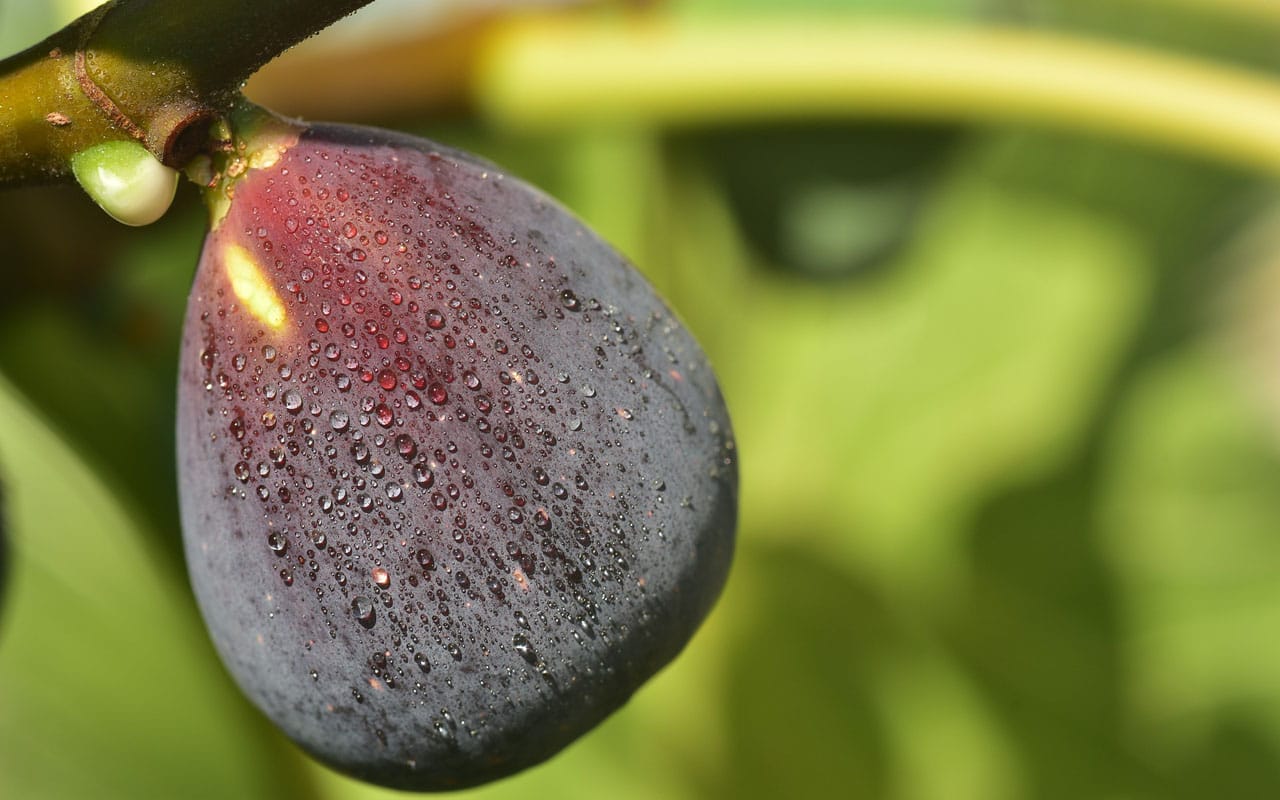
If you’ve ever eaten a really ripe fig, you know why they’re among the longest-cultivated fruit on Earth. Fig trees were grown in the Hanging Gardens of Babylon, were worshipped by the ancient Greeks, and somewhere, someone with a lonely prosciutto slice wrapped it around a fig and we’ve never looked back.
Choose a south or southwest position to plant your tree, and make sure it receives full sun. Figs like a soil pH in the neutral range, about 6 to 7 pH, and fertile soil. You’ll want to mulch around the tree to regulate soil temperatures.
Depending on your microclimate, your figs may or may not need winter wrapping. Be sure to check a fig variety’s temperature limits before planting.
If you’re short on space, we recommend planting a dwarf fig variety. Dwarf figs are also excellent candidate for espalier, where a tree is pruned to grow flat against a wall. This method has the added benefit of using radiant heat from the wall’s surface to extend the tree’s growing season.
Some fig (Ficus carica) varieties that grow well in Virginia include:
- ‘Celeste’ – light brown with pink interior
- ‘Hardy Chicago’ – light purple-brown with pink interior
- ‘Brown Turkey’ – brown with amber interior
- ‘Violet de Bordeaux’ – dark purple with red interior
- ‘Panache’ – green and yellow striped with red interior
Fig tree bark is smooth and gray, and its wood is soft and easy to prune. If your tree has a grafted rootstalk, be sure to prune off any base suckering.
Apple (Malus)

Virginia is among the top states for apple production, with about 25 varieties grown. These are grown in different conditions throughout the state. As some apple varieties need cool evening temperatures to produce high-quality fruit, be sure to check that your garden provides low-enough night-time temperatures.
For a home orchard or garden, consider a dwarf or semi-dwarf variety. Even if you have plenty of room, dwarf and semi-dwarf trees are easily kept to a safe and manageable height, require less structural pruning, and make harvesting from the ground easy and safe.
Recognizable apple varieties (genus Malus) grown in Virginia include:
- ‘Red Delicious’
- ‘Golden Delicious’
- ‘Fuji’
- ‘Winesap’
But there are many, many more! Virginia Tech publishes a comprehensive article on apple growing in the state, and you can read it here.
Or, take a cue from Thomas Jefferson and grow his Monticello favorites: ‘Esopus Spitzenburg’ and ‘Albemarle Pippin.’
Whichever varieties you choose, give your apple’s location some forethought and plant it in the best location for general health and reliable fruiting.
Apple trees need fertile, well-draining soil and protection from frost when flowering and setting fruit. Avoid low-lying areas where water and cold air may pool. Higher elevations have cooler evenings, and higher planting locations in a garden provide better soil drainage.
Crabapple (Malus)
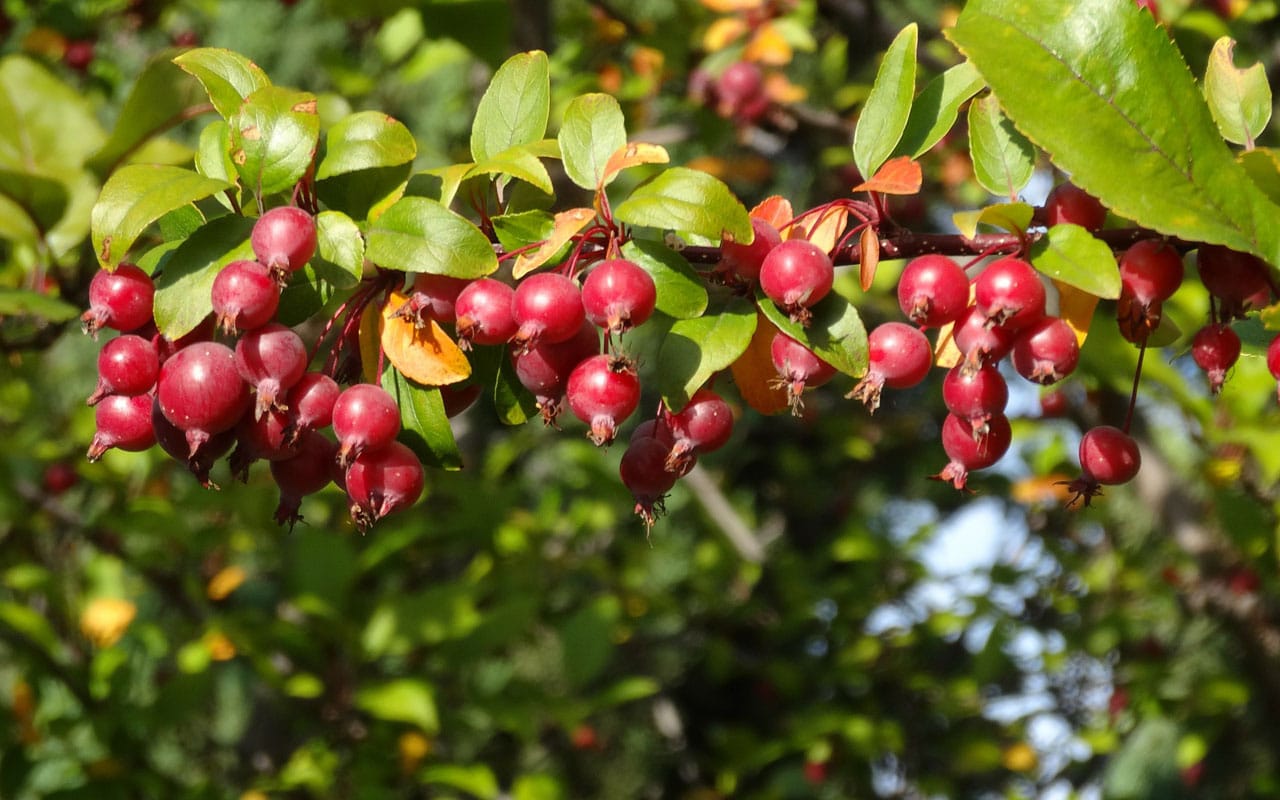
Since they’re in the same genus as apples (Malus), crabapples will want the same planting and location considerations as fruiting apples.
Crabapple varieties offer a range of flower color and fruit size, on large or small trees that may have an upright, spreading, or weeping form. Some varieties also have wonderful fall color.
Examples of crabapples recommended by Virginia Tech include:
- ‘Prairifire’ – grows to 20’ with dark red flowers and fruit
- ‘Sugar Tyme’ – grows upright to 20’ with white flowers and red fruit
- ‘Louisa’ – reaches 15’ in height with a weeping form, pink flowers and yellow fruit
But there are over 200 varieties of ornamental crabapples! Check with local nurseries for varieties suitable for our area and, as with apples, be sure to choose one that fits your propertie’s specific conditions.
NOTE: For both fruiting apples and ornamental crabapples, choose varieties that are resistant to these common diseases:
- Fireblight
- Powdery mildew
- Apple scab
- Cedar-apple rust
The native eastern red cedar, Juniperus virginiana, is the host for the cedar-apple rust fungus. If you have it on your property (or if it grows on neighboring properties), it’s even more important to select an apple or crabapple tree that’s resistant to cedar-apple rust.
Pear (Pyrus)
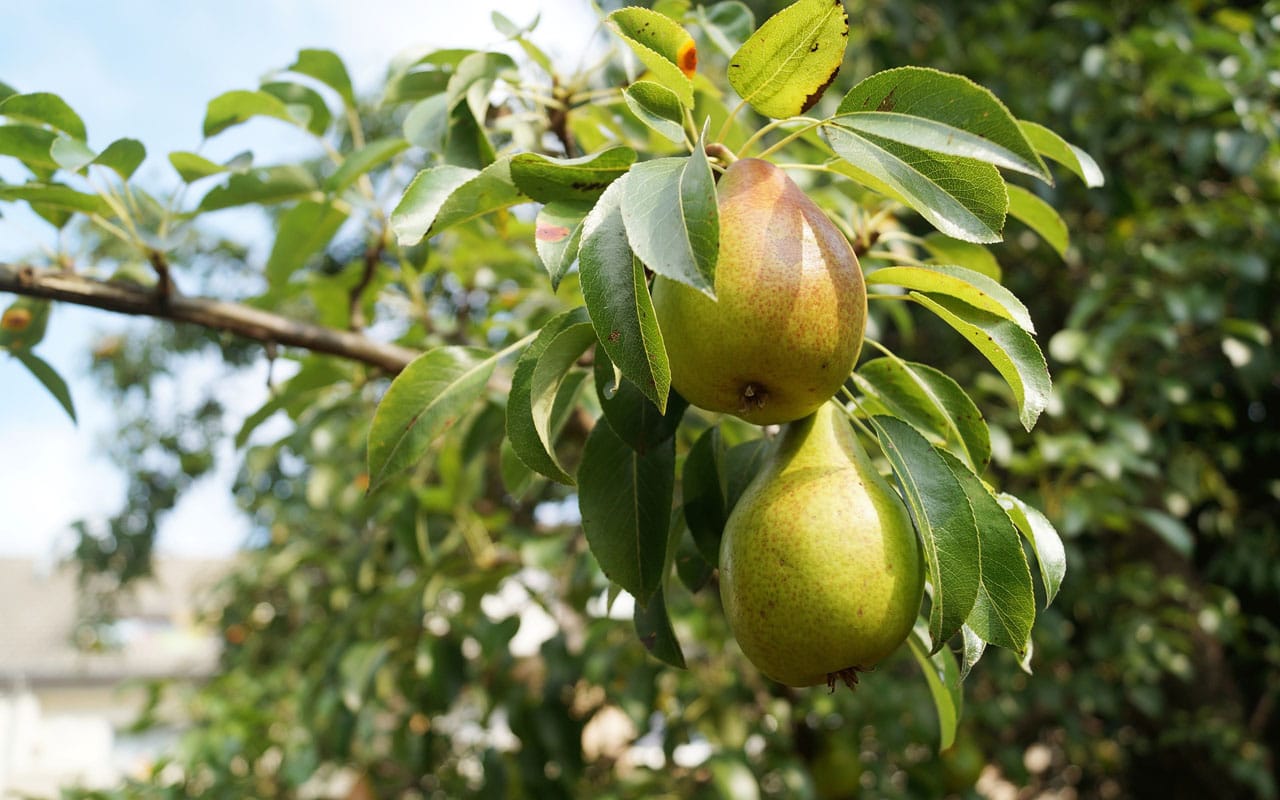
When choosing a pear variety, freezing temperatures should be your first consideration. Pears are susceptible to frost damage, so don’t plant in low areas where cold air may collect.
As with apples, pear trees want well-draining soil in full sun. Pear trees can tolerate more wet soil for longer periods than apple trees can, but should not be planted where water sits for more than a day or two.
Pear trees with vigorous growth are more likely to be affected by fireblight so make sure you’re not giving your pear trees too much nitrogen (it stimulates excessive green growth). Also, be sure to choose varieties that have shown resistance to fireblight. The most commonly available commercial pear varieties are not resistant to fireblight, so they are not listed here.
Suggestions for pear varieties include:
- ‘Harrow Delight’ – a Bartlett hybrid, with greenish yellow skin, some blushing, and smooth flesh
- ‘Seckel’ – an older variety known for its excellent small fruit and its sweet and juicy flesh
- ‘Stark Honeysweet’ – a Seckel hybrid, with large, sweet fruit that has a natural russet surface and smooth flesh
Like many apples, most pears are not self-fruitful (meaning they can’t pollinate themselves). Unlike apples, pear flowers don’t have a lot of nectar that attracts pollinators, so they need another pear variety close by (within 100 feet or so) and honeybees or other pollinating insects to visit them.
Cherry (Prunus)
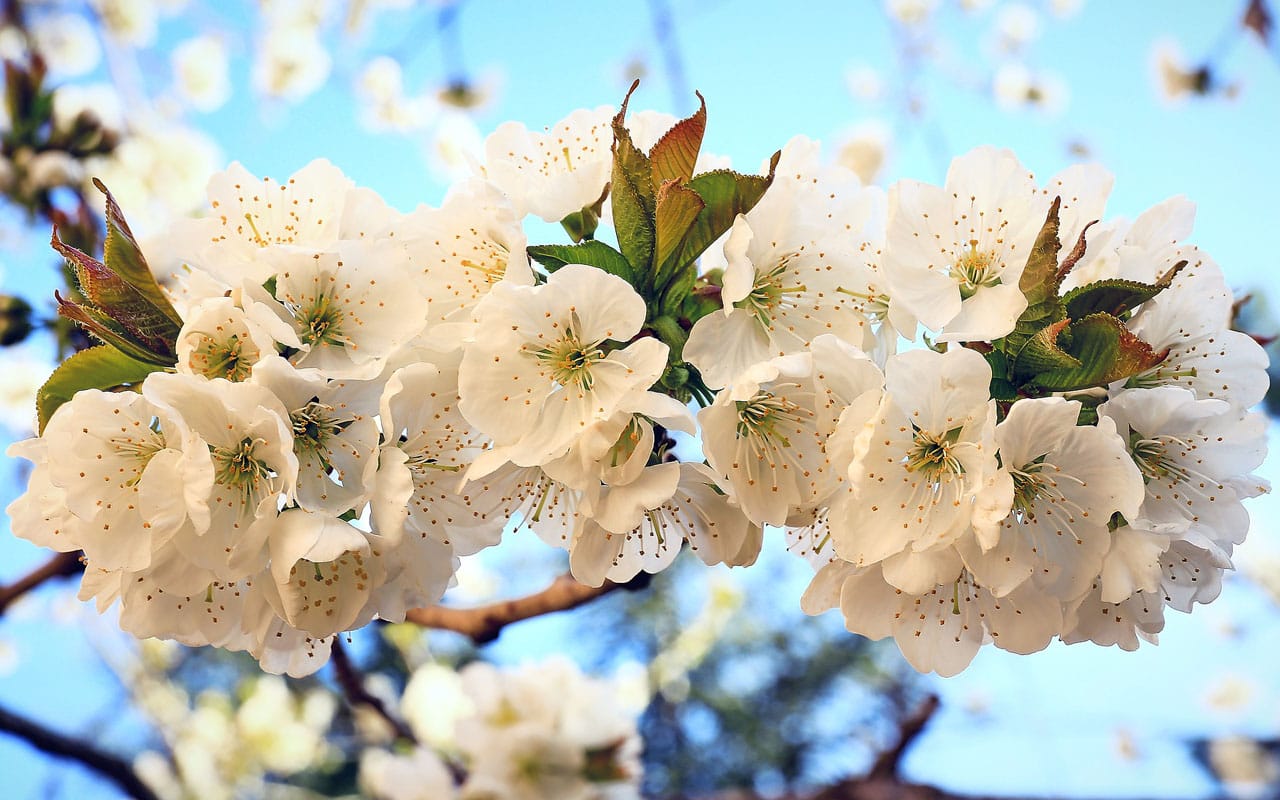
Cherries have been grown in the U.S. since English colonists first grew them from seed. Nowadays, fruiting trees are almost always grafted on rootstalk and new varieties are regularly developed.
As with apples, ornamental cherry trees aren’t just grown for their fruit – they’re also beautiful landscape trees.
Fruiting cherry trees

A 1910 drawing of Montmorency cherries
When planting cherry trees, you’ll want to choose a site similar to what other fruiting trees prefer, namely:
- Well-drained and fertile soil
- A high position, above low spots where water and cold air collect
- Protection from freezing when flowers and fruit are developing
Unlike apples or pears, however, cherries are very sensitive to climate and temperature and may be difficult to grow. Cherry trees don’t want:
- Long, hot summer weather
- Warm winter temperature spikes
- Temperature drops during bud break
- Rainfall when the fruit is ready to harvest
So make sure your garden provides conditions that will keep cherry trees healthy and productive.
The Montmorency cherry, Prunus ‘Montmorency,’ is the most popular cherry grown in Virginia and is ideal for home orchards. It is a sour cherry that’s very good for juice, pies, and jams.
Montmorency cherry trees have the following characteristics:
- Mature growth to 20’, with a spread of 15’
- Fragrant white flowers
- Dark green leaves with orange fall color
- Attractive dark red bark in winter
- Bright red fruit with a yellow interior
The native black cherry, sometimes called wild cherry, Prunus serotina, grows to 60’ or more, often in places where birds have dropped seeds. It is a valuable tree for fine woodworking and its fruits are an important food source for wildlife, but the tree isn’t grown in garden orchards.
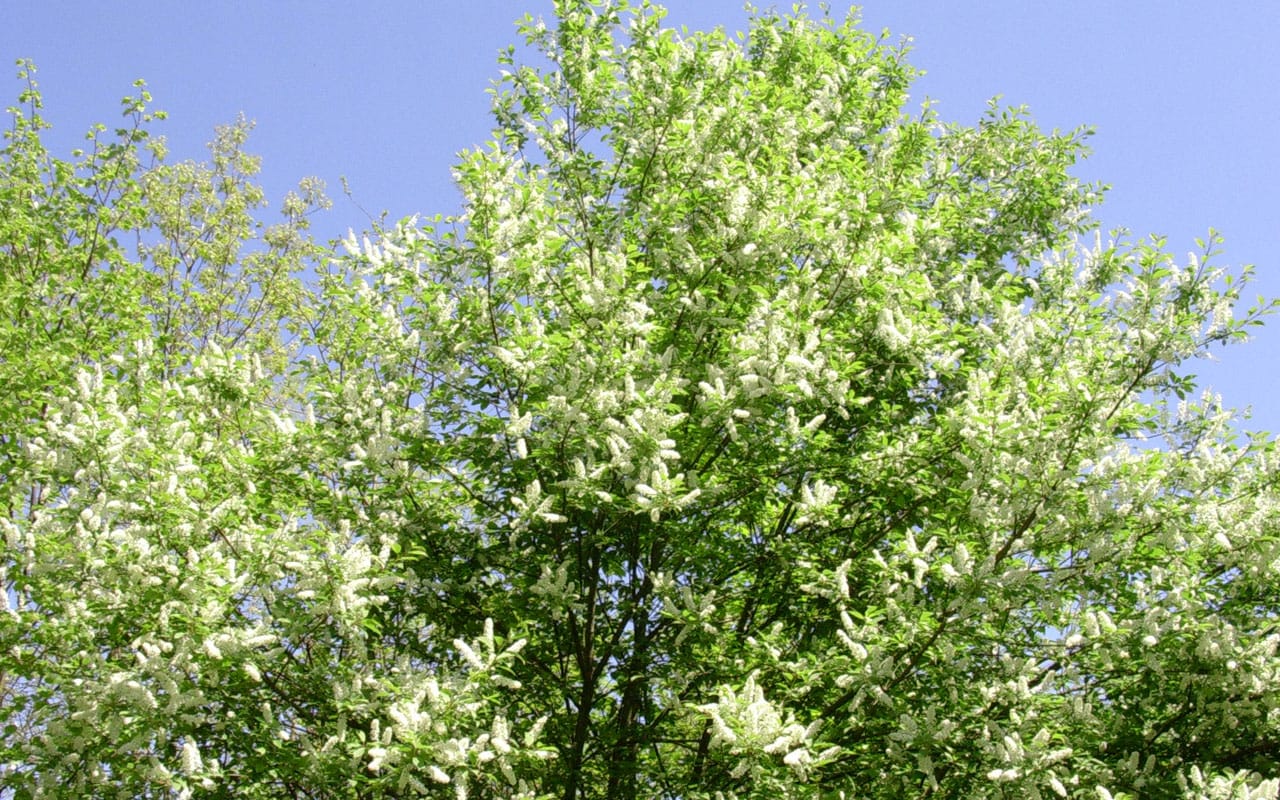
A flowering black cherry tree
Ornamental cherry trees
These trees are selected for their stunning spring flower displays, their fragrance, and their fall foliage. Their fruit is not ornamental or something you’d want to east, but birds love it. Several varieties of flowering cherry grow well in Virginia, including:
- Higan cherry, Prunus subhirtella, has pink and white spring flowers and grows to 20’ or more. Its weeping form (pendula) is especially popular.
- Yoshino cherry, Prunus x yeodensis, has white flowers and grows to 30’ or more. It produces small bitter fruit that birds eat. The Yoshino cherry is the most common cherry planted at D.C.’s Tidal Basin, along with the Kwanzan cherry.
- Kwanzan cherry, Prunus serrulata ‘Kwanzan,’ produces large, deep pink double flowers, and bronze-red new leaves. It grows to 30’ or more, with an upright habit.
- Sargent cherry, Prunus sargentii, is a large tree, to 40’ or more, and adapts to a range of conditions. It has pink flowers and bronze fall foliage.
These flowering cherry varieties make excellent ornamental garden specimens.

Higan cherry trees have an attractive weeping shape
GROWING A PERSONAL ORCHARD
Each of the fruit trees described above can be grown singly (or, for those that aren’t self-pollinating, grown in pairs). But, if you have a larger property, they can also be grown in multiples to create a personal orchard. For this kind of intensive fruit production to be successful, you’ll want to space your trees evenly, according to their mature size. Individual fruit trees should also be properly spaced from other nearby trees. This will ensure that:
- Sunlight reaches all parts of their crowns to allow optimal leaf photosynthesis and fruit ripening
- Air can move through their branches to keep leaves and fruit dry and to discourage insect pests
- Tree crowns can be safely accessed from a ladder or lift for easier pruning and spraying and, of course, fruit picking
Also include best practices that reduce the need for pesticides, such as:
- mulching around the base your trees (but keep the mulch pulled well back from the tree turnk!)
- maintaining an orchard understory with wildflowers that attract pollinators and beneficial insects
- including annual cover crops that improve soil fertility and prevent soil erosion
- regularly pruning your fruit trees (and doing so correctly at the right time of year) – here’s how and when to do it
Do those, and you’ll be able to follow William Butler Yeats’ lead to
“…walk among long dappled grass,
And pluck till time and times are done,
The silver apples of the moon,
The golden apples of the sun.”
Or, at the least, you’ll have a healthy garden orchard!
DO YOU NEED A HAND?
The best way to ensure healthy trees is to plant them correctly. Planting orchard trees and then maintaining their productivity can mean regular monitoring and preventive care. Our trained staff can advise you, and even make a plan for keeping your fruit trees healthy and productive. Just give us a call at 571-244-3838 and we’ll be happy to help you!
Get helpful tips, local news, inspiring stories, and more delivered right to your inbox every month. Don't miss another issue - join today!





